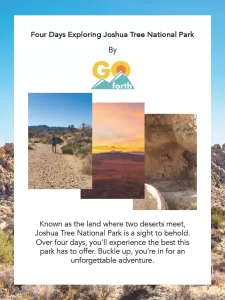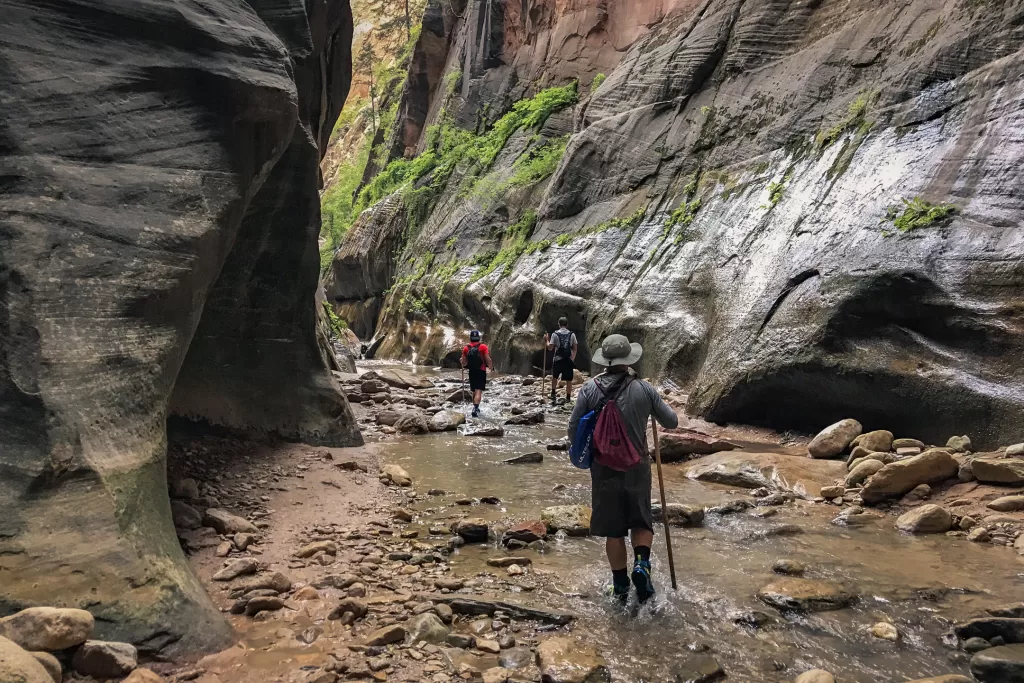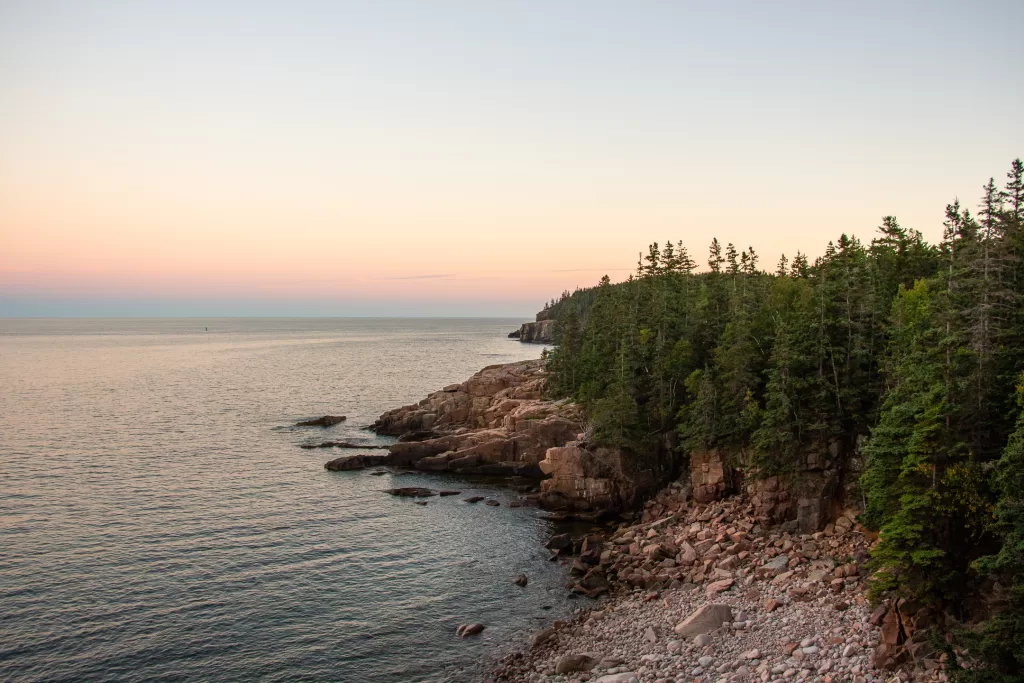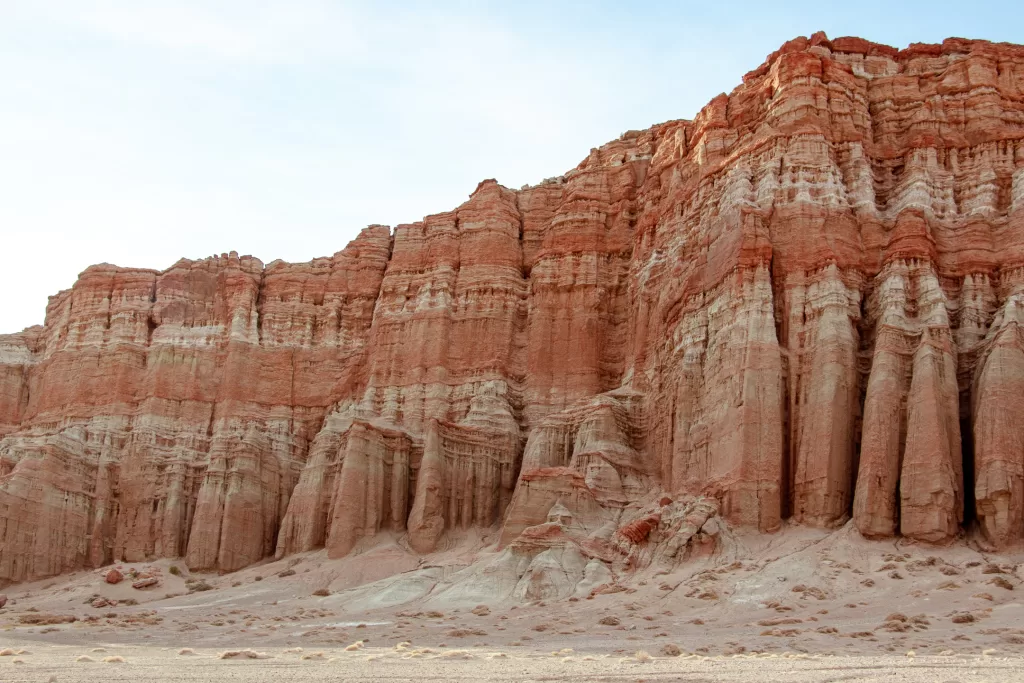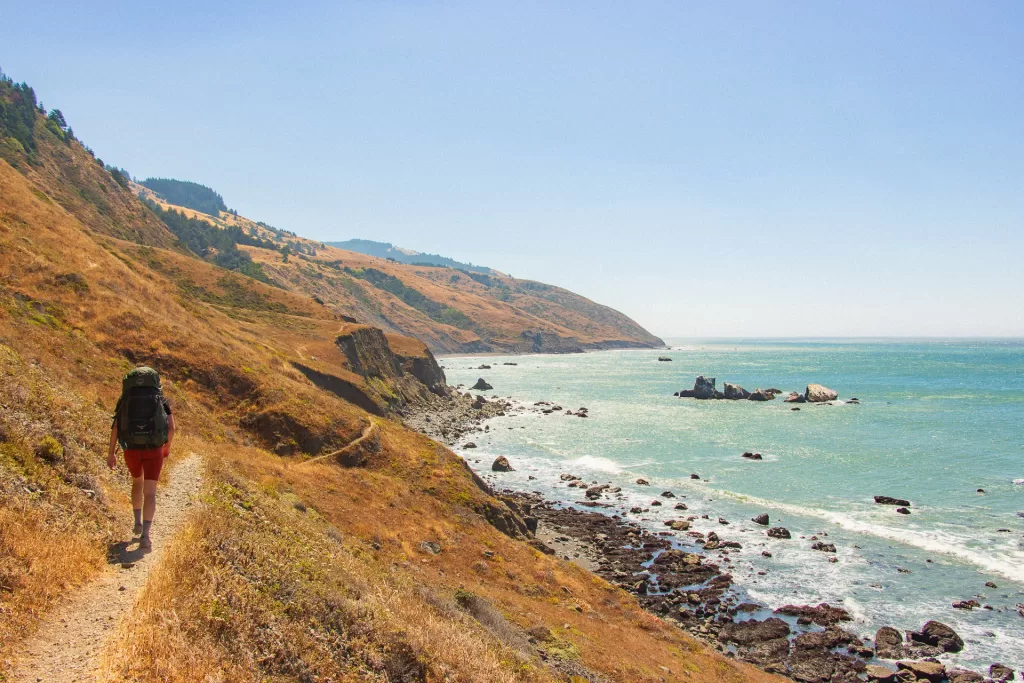Joshua Tree National Park is a mystical and one-of-a-kind place. Filled with iconic Joshua Trees, large boulder fields, intricate rock formations, and expansive desert views, you’ll feel transported to another world. As a Southern California local, I love any opportunity to explore this beautiful landscape and have made many trips to experience its magic. Through my travels, I’ve learned the ins and outs of visiting this park and want to share it with you all! So, here is my complete Joshua Tree National Park guide to help you plan your next trip to the desert.
About Joshua Tree National Park

Joshua Tree National Park is known as the place where two deserts collide. It sits at the confluence of the Colorado and Mojave deserts, creating a unique landscape filled with interesting rock outcroppings, flora and fauna, and, of course, Joshua Trees. Encompassing nearly 800,000 acres of land, and from its lowest point of 536 feet to its highest of 5,814 feet atop Quail Mountain, there are many sights to explore.
It’s located just two hours from Los Angeles and three hours from both Phoenix and Las Vegas, making it a popular destination for a weekend getaway. The park averages around 3 million visitors per year and is one of the most visited national parks in the country. It has three entrances—the west entrance outside of the town of Joshua Tree, the north entrance outside of Twentynine Palms, and the south entrance, 25 miles east of Indio along I-10.
Entrance Fees
The park’s entrance fee is $30 per standard vehicle, which is good for up to 7 days. An annual pass is $55 and allows unlimited visits 12 months from the month the pass was purchased. An Interagency Pass, like the America The Beautiful Pass, is also accepted.
Joshua Tree National Park’s Unique Geology

A highlight of Joshua Tree National Park is its unique rock formations. Starting as a molten liquid, it crystalized and became solid. Pressure, as well as wind and water, formed cracks in the granite and eroded the surrounding soil, exposing the boulder piles and outcroppings we see today. Today, erosion is still in process, and these rocks could look completely different over the next million or so years.
Joshua Tree is also home to six different mountain ranges, adding height and contrast to an otherwise flat desert landscape. These include the Coxcomb and Eagle Mountains to the east, The Little San Bernardinos to the southwest, and the Pinto, Cottonwood, and Hexie Mountains in the center. There are also several playas, or dry lake beds that occasionally fill with water after a wet year.
History of Joshua Tree National Park

The land where Joshua Tree National Park exists today has had human inhabitants for at least 10,000 years. Before white settlers discovered this place, the Cahuilla, Chemehuevi, Serrano, and Mohave peoples all called it home. In the 1870s, miners started to flock to the desert in search of gold, silver, and other lucrative minerals and resources. Few were successful, and most closed in the early 1930s. Today, there are still about 300 mines scattered throughout the park, some of which you can visit (I’ll share a few a little later).
In 1936, the park became a national monument after South Pasadena resident Minerva Hoyt lobbied for its protection from those interested in taking its cacti and other desert plants. 58 years later on October 31, 1994, the park was given its national park status via the Desert Protection Bill. Today, its allure attracts visitors from all over to catch a glimpse of its unique and whimsical terrain.
Joshua Tree National Park Flora and Fauna
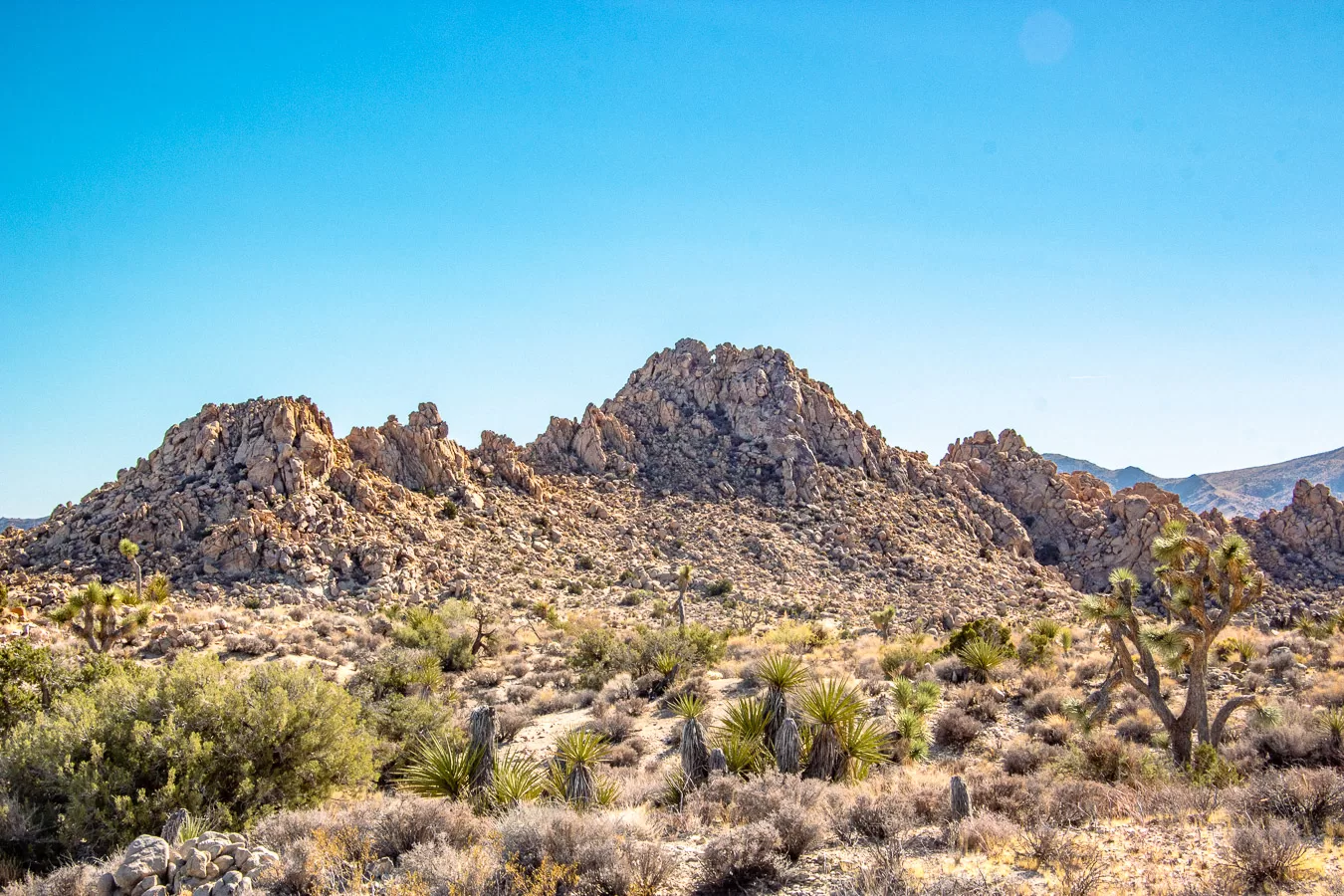
Joshua Tree National Park would not be complete without its namesake. Legend has it that these gnarled plants got their name from Mormon settlers who thought they looked like Joshua raising his hands toward the heavens. Unlike their name though, they aren’t trees but instead Yuccas, or succulent plants native to the area. Other interesting desert plants that you’ll find throughout the park include the Cholla Cactus, Ocotillo, California Fan Palm, and, in the spring, wildflowers.
Joshua Tree encompasses a variety of habitats and with it a vast variety of wildlife that have adapted to survive in the harsh, dry environment. Reptiles, such as 26 species of snakes, lizards, and the desert tortoise are all found within the park’s boundaries. There are also 57 species of mammals, including Kangaroo Rats, coyotes, and bats. However, the most notable is the Bighorn Sheep, which thrives in the more rocky areas. Also, because the park sits along the Pacific Flyway you’ll have the opportunity to catch a glimpse of many different bird species migrating between Alaska and South America.
When to Visit Joshua Tree National Park

Spring and fall are the best times to visit Joshua Tree National Park. The temperatures are more mild, ranging from the 70s and 80s during the day to the 50s at night. In the summer, daytime highs consistently reach above 100°F during the day, whereas in the winter months, night-time lows reach below freezing.
Weather in Joshua Tree National Park can fluctuate greatly, even during the spring and fall seasons. Make sure to pack layers and carry rain gear in case the temperature drops or an unexpected rainstorm rolls in.
Wildflowers
Joshua Tree National Park is a great place to view wildflowers after a wet winter. If the conditions are right (winter rains paired with sunshine and few, if any, harsh winds), you’ll see blooms as early as January and up until June. From the Desert Dandelion to the Arizona Lupine and Desert Mariposa, flowers of all shapes, sizes, and colors come to life. Joshua Tree National Park has an entire webpage to help guide your wildflower viewing in the park!
Please stay on the trails and avoid picking the wildflowers. Disturbing these delicate plants could cause them not to grow back in the future.
Check out our four-day Joshua Tree National Park pre-built itinerary! It’s full of must-know insights including essential information about weather and fees, detailed day-to-day adventures, an interactive map highlighting trailheads and must-see spots, and a hiking checklist tailored to your desert adventure.
Hiking in Joshua Tree National Park

Hiking is one of the most popular activities in the park, and with hundreds of miles of trails, there’s something for everyone. However, you will want to be fully prepared before heading out. Make sure to pack plenty of water and sun protection. Also, the weather in the desert is unpredictable, so it’s best to bring layers. Finally, many hikes are fully exposed, so start earlier in the day to avoid the worst of the heat. That said, Joshua Tree National Park is full of many amazing trails—here in this guide are a few of my favorites, separated by intensity level.
Beginner Hikes
My favorite beginner trail is the Barker Dam Loop. This 1.3-mile hike highlights many of the best things about the park, including interesting rock outcroppings, ancient petroglyphs, a grove of Joshua Trees, and the historic Barker Dam. Another great family-friendly option is the Hidden Valley Loop. This 1-mile trail routes you through massive boulder fields and Joshua Trees with interpretive signs explaining the park’s ecology and history. You might even catch some rock climbers sending it up the boulders.
Moderate Hikes
For hikers looking for a bit more adventure, consider tackling the Ryan Mountain Trail. This 3-mile hike is nothing to scoff at—you’re ascending most of the way until you reach the summit. However, you’re rewarded with panoramic views of the desert expanse. If you’re looking to experience some of the park’s mining past, consider the Lost Horse Mine Trail. This 4.1-mile hike meanders its way up a hill to one of the most profitable mines in the area. For an added challenge, consider turning your hike into a loop.
Strenuous Hikes
To escape the crowds, consider hiking the Panorama Loop. This 6.3-mile lollipop hike into the Little San Bernardino Mountains allows you to explore some of the park’s higher-elevation landscape. Or head down south to the Lost Palm Oasis Trail. Covering 7.3 miles, you’ll get to hike through a variety of terrain to a rare desert oasis filled with palm trees. If you have the energy on the way back, consider the short side trail to Mastodon Peak.
Backpacking
There are plenty of backpacking opportunities for those looking to experience the Joshua Tree backcountry. Popular trails include the 8-mile Boy Scout Trail or the 37-mile California Riding and Hiking Trail. Permits are required at all times. You can learn more about exploring the park’s backcountry on its backpacking webpage.
More Recreation Opportunities
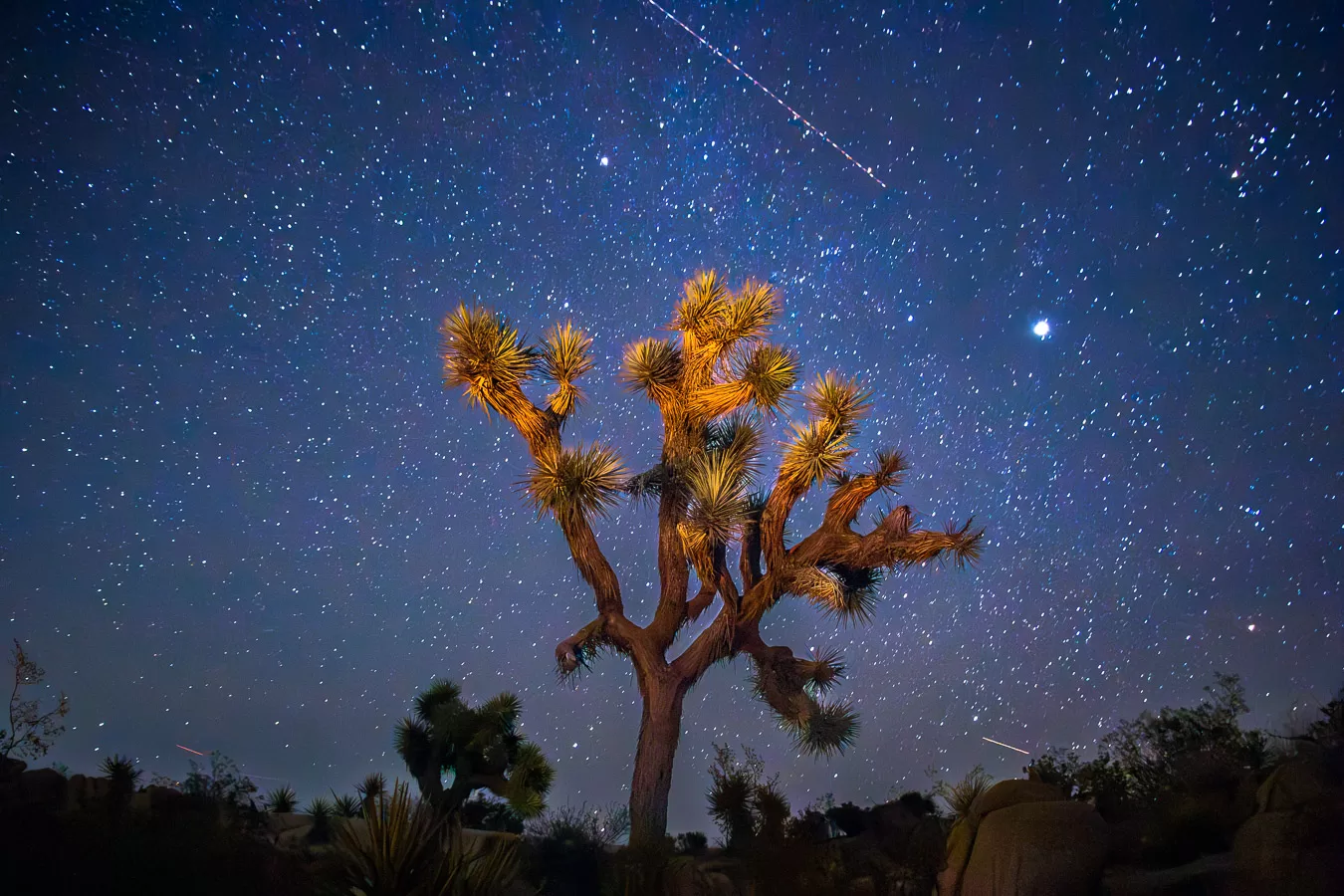
Joshua Tree National Park is a mecca for rock climbers and draws people from all over to scale its many interesting boulders. There are also several backcountry roads for four-wheel drive vehicles and mountain bikers to explore. And for those looking to experience the park on horseback, there are 253 miles of trails you can roam.
Due to its remote location and expansive landscape, stargazing is also a popular activity within the park. For the best experience, aim for a clear night during a new moon.
Joshua Tree National Park Rock Formations
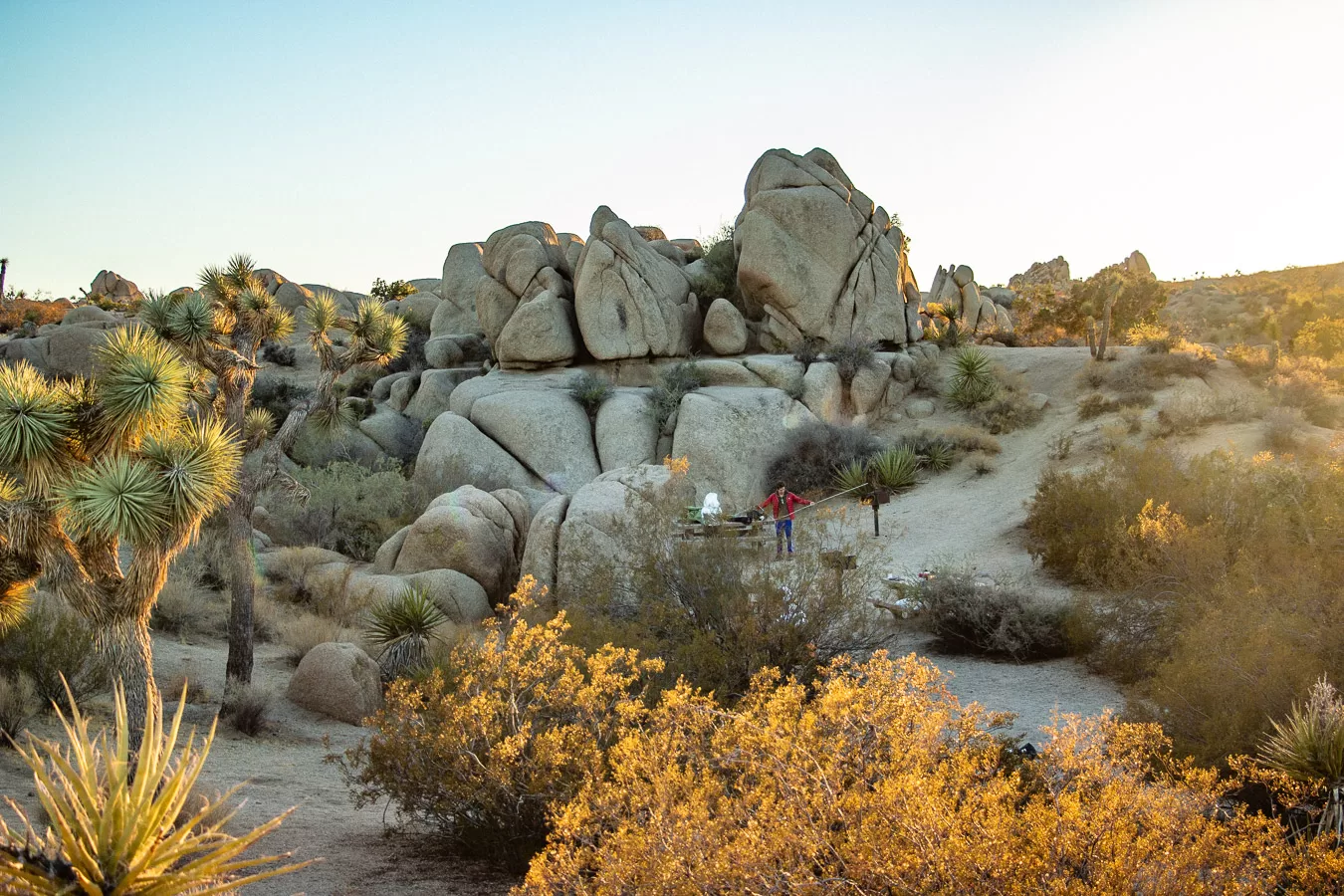
The park’s rock formations are unlike those found anywhere else. Carved over millions of years, these geological wonders are on full display. Many of the most interesting are reachable with little or no hiking, making them great stops for the entire family. Note that these spots can get very popular, so don’t expect to witness them by yourself. While there are many rock formations throughout Joshua Tree National Park, here in this guide are four rugged outcrops that are worth visiting.
Skull Rock
Located by the Jumbo Rocks Campground, Skull Rock is a must-visit stop for those visiting the park and is viewable from the road. Feel free to scramble around in the nearby boulder field if you’re feeling up to it.
Arch Rock
Arch Rock is reached via a short hike from the Twin Tanks parking lot by the White Tank Campground. Here, you’ll see a large, naturally occurring arch that you can walk through.
Heart Rock
After visiting Arch Rock, take a spur trail and head to Heart Rock. As the name suggests, this geological outcropping eroded in such a way that it resembles a giant heart!
Split Rock
Though it requires a little more effort to reach, Split Rock is also worth viewing. Head along a 2.5-mile trail just across the road from Skull Rock to witness the towering boulder seemingly split perfectly in half.
Joshua Tree National Park Notable stops and viewpoints

Several stops and viewpoints throughout Joshua Tree National Park are worth visiting and in this guide, you’ll find a few of my favorite places.
Keys View
For one of the best views in the entire park, check out Keys View. This viewpoint high in the Little San Bernardino Mountains is reachable by car and features expansive desert vistas. Get there early if you’re planning on experiencing sunset here, as the parking lot will quickly fill up.
Cholla Cactus Garden
Located centrally is the Cholla Cactus Garden. An impressive and rare stand of Teddybear Cholla Cacti dominates the landscape. Just don’t get too close or you might get poked!
Wall Street Mill
By Barker Dam is Wall Street Mill. It requires a two-mile round-trip hike to reach, but you’ll get to witness the remains of an old mill used to process gold, complete with mill equipment, an old homestead, and abandoned cars.
Keys Ranch
For a truly unique experience, try to visit Keys Ranch. It’s located in a remote corner of Joshua Tree National Park and only accessible via a ranger as your guide. If you snag a ticket, however, you’ll get to learn all about the area’s Native American, mining, and ranching history, as well as see the impressively preserved Keys Ranch. Spots are limited, and you can grab tickets ahead of time at recreation.gov.
Joshua Tree National Park Camping
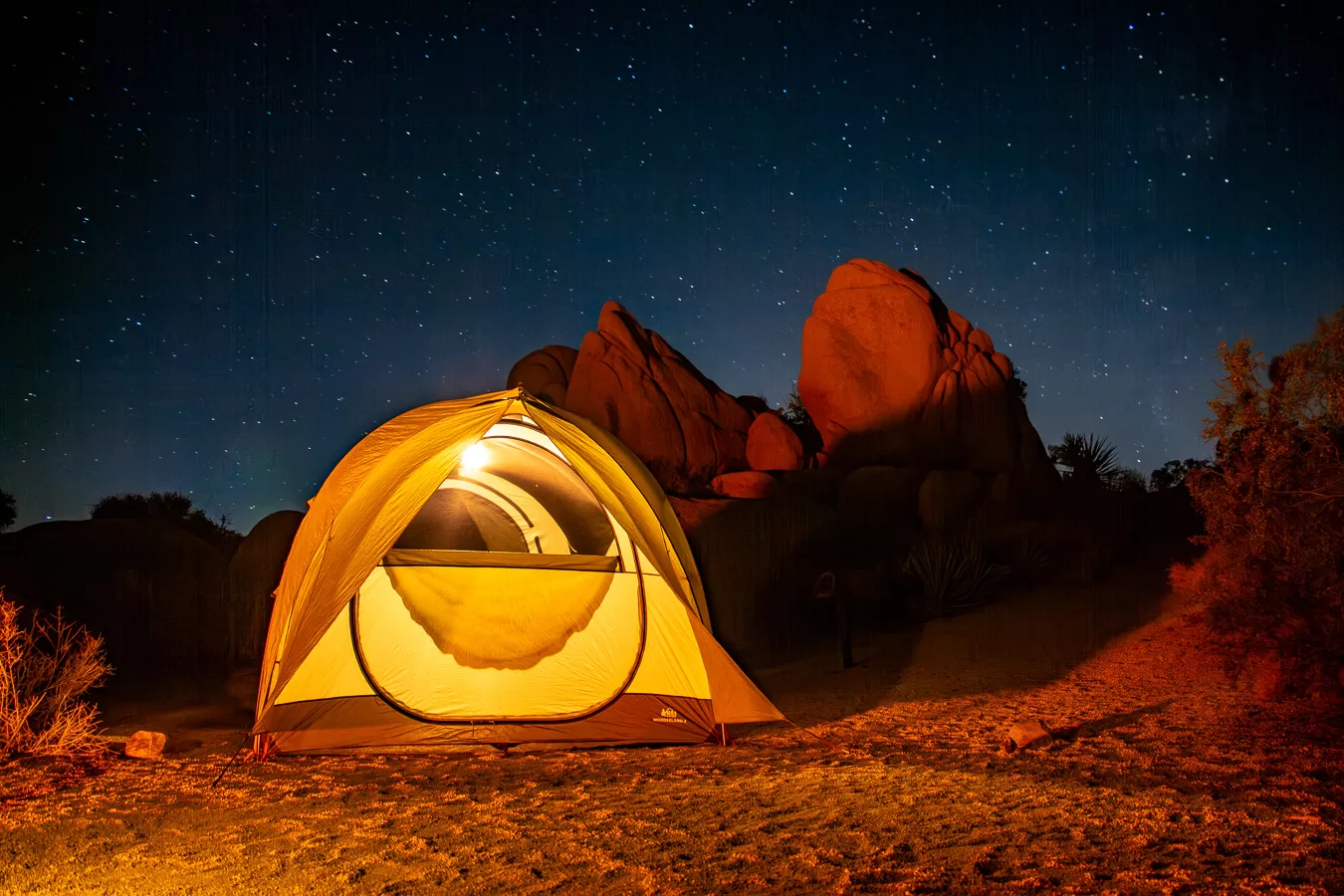
If you’re planning on camping in Joshua Tree National Park, you’re in luck. There are 500 campsites over nine campgrounds throughout the park. Before you leave, read our article about our eight tips for a successful desert camping adventure.
Sites Requiring a Reservation
There are six campgrounds in Joshua Tree National Park that you can book ahead of time. Reservations are released six months in advance on a rolling basis at 7 am Pacific Time. Sites can book up quickly so it’s best to be ready to book as soon as reservations open. Any available campsites within the six-month reservation window can be claimed at any time.
Black Rock Campground
Black Rock Campground is in the park’s northwest corner. 99 sites that are available to book year-round. It’s near the Little San Bernardino Mountains and close to the Panorama Loop Trail. It also is only five miles from the town of Yucca Valley, meaning restaurants, shopping, and other services are close by.
Cottonwood Campground
Cottonwood Campground in the park’s southern section. It is located off Highway 10, a little over 30 miles east of Indio. 62 sites that are available to book year-round. Mastodon Peak and the Lost Palms Oasis Trail are both walkable from the campground. You also are a 30-minute drive from the Cholla Cactus Garden, which makes a great stop on your way back from hikes in the northern section of the park.
Indian Cove Campground
Indian Cove Campground is in the northern section of the park, ten miles west of the nearest city, Twentynine Palms. 101 sites are available to book year-round. A highlight in this area is the Wonderland of Rocks, a 12-square-mile maze of jumbled boulders and washes. A short drive away is the Fortynine Palms Oasis Trail, a short 3.2-mile hike to one of the few oases in the park.
Jumbo Rocks Campground
Jumbo Rocks Campground is centrally located within the park. 124 sites are available to book year-round. Its defining feature is the large boulders (hence the name) that are scattered throughout the area, which are perfect for climbing and exploring. Skull Rock Trail starts by the campground’s entrance and leads you to one of the most iconic rock formations in the park. Another point of interest nearby includes the Desert Queen Mine, a once-active gold mine that is now included in the National Register of Historic Places.
Ryan Campground
Ryan Campground is centrally located in the park. 31 sites are available to book year-round. it’s adjacent to the 37-mile California Hiking and Riding Trail and also nearby is Ryan Mountain, which is a great spot to view the sunset. The Hall of Horrors is a short drive away and features several interesting rock formations.
Sheep Pass Group Campground
Sheep Pass Group Campground is centrally located in the park. 6 sites are available to book year-round, with a minimum of 10 people per site. Close to the site are the Wall Street Mill and Barker Dam Trails. If you don’t feel like hiking, you can still experience the Joshua Trees and the otherworldly rock structures surrounding the campground.
First-Come, First-Served Sites
Joshua Tree National Park has three first-come, first-served sites. Campers should first occupy an empty site and then head to the entrance station to pay the campsite fee. Payment can be made the next day if the station is closed.
Belle Campground
Belle Campground is located centrally in the park, about 10 miles south of Twentynine Palms. It features 18 campsites and is normally open from September through May (closed in the summer). It features lots of nearby rock formations and is close to the Arch Rock trail.
White Tank Campground
White Tank Campground is located centrally in the park, about 12 miles south of Twentynine Palms and 1.5 miles south of Belle Campground. There are 15 campsites and is normally open from September through May (closed in the summer). Arch Rock and Heart Rock are within walking distance from the campsite, and it’s in one of the darkest sections of the park making it a great place for stargazing.
Hidden Valley Campground
Hidden Valley Campground is located in the park’s northern section, about 14 miles southeast of the town of Joshua Tree. There are 44 sites and it’s open year round. This is a great basecamp for those looking to climb, as there are many boulders in the area. Those who want to hike can check out the Barker Dam Trail or Hidden Valley Trail, which are both nearby.
I hope that this Joshua Tree National Park guide inspired a California desert adventure! If you’re looking for help planning your next trip to Joshua Tree National Park, please reach out! We at GoForth are here to give you back hours in your day, and we’d love to help you curate an unforgettable trip. Click on the button below to learn more about our offerings, and contact us if you’re ready to take the first step toward a life outdoors!


